牛津英语初二8A第四单元说课教案
- 格式:doc
- 大小:63.00 KB
- 文档页数:10
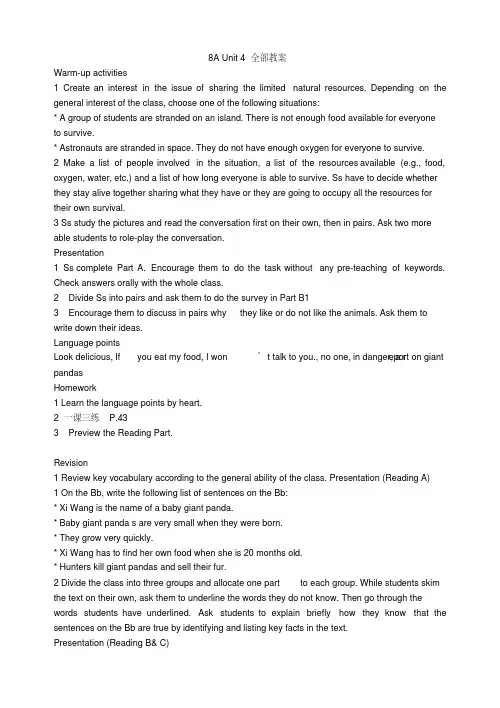
8A Unit 4全部教案Warm-up activities1 Create an interest in the issue of sharing the limited natural resources. Depending on the general interest of the class, choose one of the following situations:* A group of students are stranded on an island. There is not enough food available for everyoneto survive.* Astronauts are stranded in space. They do not have enough oxygen for everyone to survive.2 Make a list of people involved in the situation, a list of the resources available (e.g., food, oxygen, water, etc.) and a list of how long everyone is able to survive. Ss have to decide whether they stay alive together sharing what they have or they are going to occupy all the resources for their own survival.3 Ss study the pictures and read the conversation first on their own, then in pairs. Ask two more able students to role-play the conversation.Presentation1 Ss complete Part A. Encourage them to do the task without any pre-teaching of keywords. Check answers orally with the whole class.2 Divide Ss into pairs and ask them to do the survey in Part B13 Encourage them to discuss in pairs why they like or do not like the animals. Ask them to write down their ideas.Language pointsLook delicious, If you eat my food, I won’t talk to you., no one, in danger, a report on giant pandasHomework1 Learn the language points by heart.2 一课三练P.433 Preview the Reading Part.Revision1 Review key vocabulary according to the general ability of the class. Presentation (Reading A)1 On the Bb, write the following list of sentences on the Bb:* Xi Wang is the name of a baby giant panda.* Baby giant panda s are very small when they were born.* They grow very quickly.* Xi Wang has to find her own food when she is 20 months old.* Hunters kill giant pandas and sell their fur.2 Divide the class into three groups and allocate one part to each group. While students skim the text on their own, ask them to underline the words they do not know. Then go through the words students have underlined. Ask students to explain briefly how they know that the sentences on the Bb are true by identifying and listing key facts in the text.Presentation (Reading B& C)1 Ask Ss to draw a parallel between the growth of the baby giant panda and a human baby. Askif they know what happens to people while they grow up. Write the following words/phrases onthe Bb.Adult old person teenager baby middle-aged personYoung adult child toddlerDraw a timeline and encourage Ss to come forward and write each word at the correct point onthe timeline. Ask them to draw a more creative growth chart.2 Ask students to do a birth chart of themselves. Tell them to add their photos to the chart.Presentation (Reading D)1 Revise the words listed in the box in Part D.2 Ask students to complete Part D. Then ask some Ss to read the sentences aloud to check theirchoice of words.3 If they show interest, ask them to practice the text for a presentation for 2-3 minutes.Presentation (Reading E)1 Ask Ss to read the conversation in Part E in pairs to check if there are any words they do notknow. Then ask Ss to complete the sentences individually.2 Ask six Ss to read the conversation while the rest of the class check their answers.Language points (Part A)The story of Xi Wang, only 10 days old, it means…, was born, weigh just 100 grams, at fourmonths, for the first time, eight months later, not…any more, grow into, at the very beginnin up to 14 hours a day, bamboo shoots, have to look after herself, have another baby, It is adj. (forsb.) to do, some of the problems, kill it for its fur, nowhere to live, on their own, need help, indanger, take the following actions to do, protect giant pandas, make giant panda reserves bigger,encourage sb. to do, there will beLanguage points (Part B& C)Keep sb./sth. Safe from danger, large areas of land with trees, special areas for wild animals, stayaliveHomework1 Learn the language points by heart.2 一课三练P.44-453 Preview the V ocabulary Part.Presentation (Vocabulary)1 Creat an interest in animals. Try to extend the context by asking Ss if they would like to adoptan animal and , if they do, which one they would choose.2Use the task to check Ss’knowledge of name of animals. Ask Ss to guess the namesindividually first and then compare with a partner.3 Check answers with the whole class. Read all the words under the pictures and ask Ss to givedefinitions.Language pointsPolar bear---North Pole, wolf----wolvesHomework1 Learn the language points by heart.2 一课三练P.463 Preview the Grammar Part.Presentation (Grammar Part A)1 Try to elicit the conditional structure by asking questions such as What will happen if you come to school lats? What will happen if you break your favourite toy? Try to think of sentences own experience. Write the most interesting answers on the Bb. Ask Ss to which reflect Ss’ -clause as well. Read all the sentences again and ask more able Ss to elicit the include the “If”rule.-clauses on the Bb and ask Ss to finish the sentences with their own 2 Write some more open “If”ideas. Help Ss reformulate their ideas into correct sentences and write them on the Bb.3 Ask Ss to match the sentences on their own and then compare answers with a partner. Invite a more able student to read the sentences aloud for the rest of the class to check answers.4 For Part A2, Ask Ss to complete the sentences on their own and then compare answers with a partner. Check answers with the whole class.age 61.5 Ask Ss to complete “Work out the rule” at the bottom of pPresentation (Grammar Part B)1 Ask Ss to read through the rules and the sample sentences on their own. Then check understanding by asking them to think of other examples.-clauses on the Bb and ask more able Ss to complete them with their own2 Write several “If”ideas. Remind them to write about repeated and predictable situations instead of possible results.3 Explain the context of Part B1. Revise the words in the box.4 Ask students to complete the sentences individually.5 Ask Ss to read the conversation with a partner checking the accuracy of their sentences. Then check answers with the class.Presentation (Grammar Part B2)1 Try to creat interest in learning interesting things about wild animals. Tell them that Amyreport introduces new information about tigers and wolves.2 Explain the context of writing a report. Revise the structure of conditional sentences.3 Ask Ss to read the report on their own to make sure that there are no unfamiliar words. Then Ss complete the sentences individually and compare them with a partner. Check answers with the whole class.Language pointsGrow more bamboo, run the other way, go to North Africa, walk through a rainforest, learn a lot about wild animals, arrive at noon, see the feeding of animals, get enough information for myclass report, attack people, spit poison, step on them, male wolvesHomework1 Learn the language points by heart.2 一课三练P.47-483 Preview the Integrated skills Part.Presentation (Integrated skills A)1 Invite students to talk about what they like about tigers and wolves. Brainstorm any information and general knowledge about the two animals.2 Ask Ss to study the two fact files in pairs. Check the meaning of some of the words.3 Help Ss focus on the general context by asking general questions they may be able to answer while listening for the first time. Write them on the Bb:* What is the name of the largest living cat?* What is Millie’s favourite animal?Play the recording. Students listen carefully for keywords to answer the questions.4 Play the recording for again and ask students to find out the missing facts in the fact sheets. Play the tape for the third time for Ss to check the answers.5 Ask Ss to read the letter in pairs and discuss any words they do not understand. Complete the letter without looking at the fact sheetson page 64. Then ask them to look at the fact sheets to check the answers and make corrections if necessary.6 Ask more able Ss to read aloud the letter.Presentation (Integrated skills B)1 Ask students to practice the conversation in pairs and then change roles. Identify any wordsor phrases they do not know.2 Ask students to create their own conversation using information from the fact sheets. Language pointsLive as a family, good at hunting other animals, make medicine, friendly towards each other, loss of living areas, make medicine from their bones, buy clothes made of animal fur, look lovely on me, lose one’s life, someone else,Homework1 Learn the language points by heart.2 一课三练P.493 Preview the Pronunciation, Main task & Check out Part.Presentation (Pronunciation)1 Remind Ss of communicative purpose of conditional sentences.2 Play the recording for Part A and ask Ss to listen carefully. Ss imitating the rising and falling voice patterns.3 Ask students to read Simon’s presentation with correct the rising and falling voices.4 Ask students to read Millie’s presentation in Part B quietly on their own. Play the recording .Ask Ss to listen carefully and mark where Millie’s voice rises and falls with the correct arrows.5 Tell students to read them again, and answer the ‘Wh-‘questions. Students work in pairs.Language points (Pronunciation)Peaceful animals, live in family groups, continue to build roads, have suitable homes, makenew farmland, make a lot of money, sell elephants’ tusks, train them,Presentation(Main task)1 Talk to Ss about the purpose of writing reports. Elicit from the different reports. Explain that inreports, we do not normally say ‘I feel…’ or ‘I like…’ and do not include personal co 2 Read the title of the report in Part A. Create an interest in the topic by asking what they havelearnt about giant panda in this unit.3 Ask students to skim through the report quickly and give each paragraph.4 Ss complete Simon’s report in Part C on their own. Ask more able Ss to read it aloud to checkthe answers.Language points (Main task)Spend a lot of time drinking their mums’ milk, at a time, get smaller and smaller, become farmlands, keep taking the land, what action can the club take? Sharp paws, walk uprightPresentation (Checkout)1 Set a time limit for reading the sentences in Part A and for filling the blanks. Ask Ss tocomplete the task on their own.2 Ask students to Proceed to Part B after completing Part A.3 Ss complete Part B on their own and then compare answers in pairs.Language points (Checkout)Climbing, what about playing football?, a friend like Alan, answer questions correctlyHomework1 Learn the language points by heart.2 一课三练P.50-523 Preview the Unit 5。
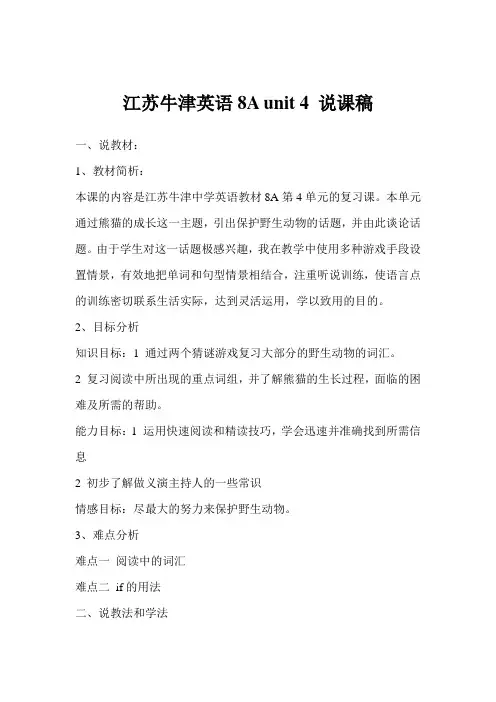
江苏牛津英语8A unit 4 说课稿一、说教材:1、教材简析:本课的内容是江苏牛津中学英语教材8A第4单元的复习课。
本单元通过熊猫的成长这一主题,引出保护野生动物的话题,并由此谈论话题。
由于学生对这一话题极感兴趣,我在教学中使用多种游戏手段设置情景,有效地把单词和句型情景相结合,注重听说训练,使语言点的训练密切联系生活实际,达到灵活运用,学以致用的目的。
2、目标分析知识目标:1 通过两个猜谜游戏复习大部分的野生动物的词汇。
2 复习阅读中所出现的重点词组,并了解熊猫的生长过程,面临的困难及所需的帮助。
能力目标:1 运用快速阅读和精读技巧,学会迅速并准确找到所需信息2 初步了解做义演主持人的一些常识情感目标:尽最大的努力来保护野生动物。
3、难点分析难点一阅读中的词汇难点二if的用法二、说教法和学法根据我对《英语课程标准》的理解和九年级学生的生理和心理特点,我将教学本课的指导思想确定为:让学生主体参与,主动探究,合作互动,充分发展。
具体采用如下教学方法:1、情景教学法:通过设置较为真实的情景,如视频、图片、动物世界的开头曲与片尾曲等,使学生产生身临其境的感觉,激起学生情感上的共鸣,从而引导学生从整体上理解和运用语言,促进学生的语言能力及情感、意志、想象力、创造力等整体发展。
2.任务型教学法:我设计了各种任务,通过感知、体验、参与和合作等活动方式,使学生的主体地位得到充分体现。
例如,要求学生阅读文章,完成填空等。
3、头脑风暴法:把大多课堂时间留给学生,使学生在多信息、高密度、快节奏的灵活操练中拓宽学习渠道。
三、说教学程序1、视频“动物世界”导入,采用直观法,引起学生共鸣,激发学生学习兴趣也为后面的教学做了一个提早渗透;2.然后采用了游戏法,第一个游戏把动物的图片遮掉一半,让学生猜,使学生首先在心理上感到放松,学生在轻松愉快的气氛中进入本课的学习,第二个游戏让学生把字母顺序混乱的单词重新排列,复习单词。
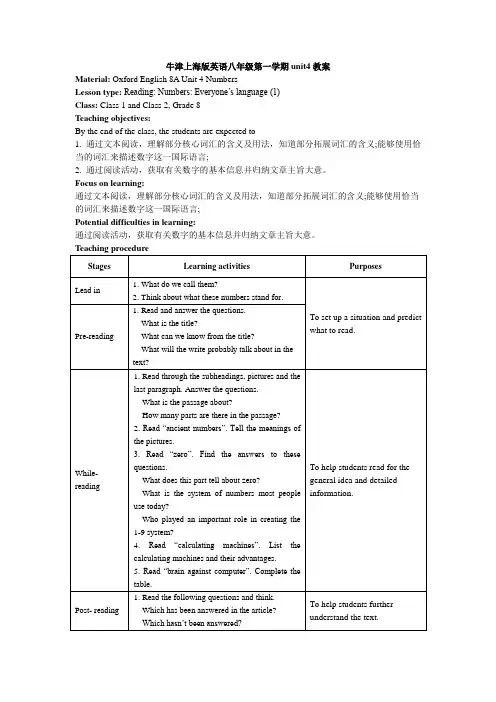
牛津上海版英语八年级第一学期unit4教案Material: Oxford English 8A Unit 4 NumbersLesson type:Reading: Numbers: Everyone’s language (1)Class: Class 1 and Class 2, Grade 8Teaching objectives:By the end of the class, the students are expected to1. 通过文本阅读,理解部分核心词汇的含义及用法,知道部分拓展词汇的含义;能够使用恰当的词汇来描述数字这一国际语言;2. 通过阅读活动,获取有关数字的基本信息并归纳文章主旨大意。
Focus on learning:通过文本阅读,理解部分核心词汇的含义及用法,知道部分拓展词汇的含义;能够使用恰当的词汇来描述数字这一国际语言;Potential difficulties in learning:通过阅读活动,获取有关数字的基本信息并归纳文章主旨大意。
Stages Learning activities PurposesLead in 1. What do we call them?2. Think about what these numbers stand for.To set up a situation and predictwhat to read.Pre-reading 1. Read and answer the questions.What is the title?What can we know from the title?What will the write probably talk about in the text?While- reading 1. Read through the subheadings, pictures and thelast paragraph. Answer the questions.What is the passage about?How many parts are there in the passage?2. Read “ancient numbers”. Tell the meanings ofthe pictures.3. Read “zero”. Find the answers to thesequestions.What does this part tell about zero?What is the system of numbers most peopleuse today?Who played an important role in creating the1-9 system?4. Read “calculating machines”. List thecalculating machines and their advantages.5. Read “brain against computer”. Complete thetable.To help students read for thegeneral idea and detailedinformation.Post- reading 1. Read the following questions and think.Which has been answered in the article?Which hasn’t been answered?To help students furtherunderstand the text.Which can be inferred from the article?Are all the answers questions closely related to the title “numbers: everyone’s language’? Explain your reason.AssignmentsCopy the new words and phrases you learnedin today's lesson. Then read them aloud after therecording.Think and answer the second question inTask 3 on your worksheet.Complete Exercises C (CI, C2, C3) and D(DI, D2) on pages 58 and 59, Student's Book.Read the passage aloud after the recordingthree times.To consolidate what is learnt inclass.Material: Oxford English 8A Unit 4 NumbersLesson type:Reading: Numbers: Everyone’s language (2)Class: Class 1 and Class 2, Grade 8Teaching objectives:By the end of the class, the students are expected to1. 通过阅读,了解说明文的文体特征,判断文章说明对象,辨别作者所使用的说明方法;2. 在阅读中,识别段落主题句,判断作者使用的细节支撑类型; 进一步探讨各段落与标题的匹配度,完善主题信息。
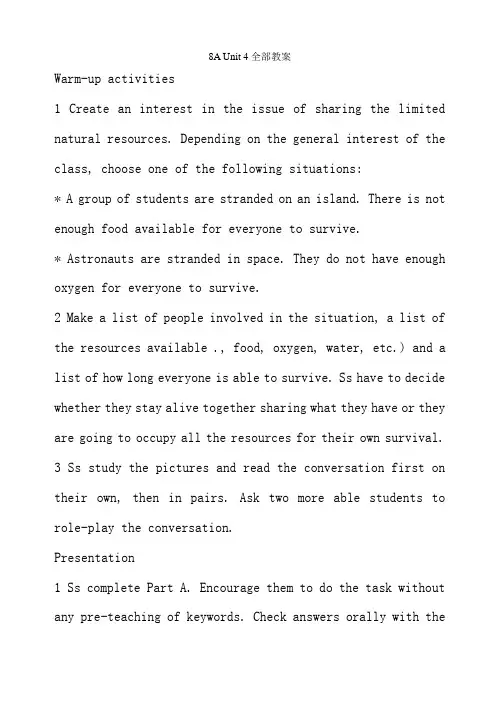
8A Unit 4全部教案Warm-up activities1 Create an interest in the issue of sharing the limited natural resources. Depending on the general interest of the class, choose one of the following situations:* A group of students are stranded on an island. There is not enough food available for everyone to survive.* Astronauts are stranded in space. They do not have enough oxygen for everyone to survive.2 Make a list of people involved in the situation, a list of the resources available ., food, oxygen, water, etc.) and a list of how long everyone is able to survive. Ss have to decide whether they stay alive together sharing what they have or they are going to occupy all the resources for their own survival.3 Ss study the pictures and read the conversation first on their own, then in pairs. Ask two more able students to role-play the conversation.Presentation1 Ss complete Part A. Encourage them to do the task without any pre-teaching of keywords. Check answers orally with thewhole class.2 Divide Ss into pairs and ask them to do the survey in Part B13 Encourage them to discuss in pairs why they like or do not like the animals. Ask them to write down their ideas. Language pointsLook delicious, If you eat my food, I won’t talk to you., no one, in danger, a report on giant pandasHomework1 Learn the language points by heart.2 一课三练3 Preview the Reading Part.?Revision1 Review key vocabulary according to the general ability of the class. Presentation (Reading A)1 On the Bb, write the following list of sentences on the Bb: * Xi Wang is the name of a baby giant panda.* Baby giant panda s are very small when they were born.* They grow very quickly.* Xi Wang has to find her own food when she is 20 months old. * Hunters kill giant pandas and sell their fur.2 Divide the class into three groups and allocate one part to each group. While students skim the text on their own, ask them to underline the words they do not know. Then go through the words students have underlined. Ask students to explain briefly how they know that the sentences on the Bb are true by identifying and listing key facts in the text. Presentation (Reading B& C)1 Ask Ss to draw a parallel between the growth of the baby giant panda and a human baby. Ask if they know what happens to people while they grow up. Write the following words/phrases on the Bb.Adult old person teenager baby middle-aged personYoung adult child toddlerDraw a timeline and encourage Ss to come forward and write each word at the correct point on the timeline. Ask them to drawa more creative growth chart.2 Ask students to do a birth chart of themselves. Tell them to add their photos to the chart.Presentation (Reading D)1 Revise the words listed in the box in Part D.2 Ask students to complete Part D. Then ask some Ss to read the sentences aloud to check their choice of words.3 If they show interest, ask them to practice the text for a presentation for 2-3 minutes.Presentation (Reading E)1 Ask Ss to read the conversation in Part E in pairs to check if there are any words they do not know. Then ask Ss to complete the sentences individually.2 Ask six Ss to read the conversation while the rest of the class check their answers.Language points (Part A)The story of Xi Wang, only 10 days old, it me ans…, was born, weigh just 100 grams, at four months, for the first time, eight months later, not…any more, grow into, at the very beginning, up to 14 hours a day, bamboo shoots, have to look after herself, have another baby, It is adj. (for sb.) to do, some of the problems, kill it for its fur, nowhere to live, on their own, need help, in danger, take the following actions to do, protectgiant pandas, make giant panda reserves bigger, encourage sb. to do, there will beLanguage points (Part B& C)Keep sb./sth. Safe from danger, large areas of land with trees, special areas for wild animals, stay aliveHomework1 Learn the language points by heart.2 一课三练3 Preview the Vocabulary Part.?Presentation (Vocabulary)1 Creat an interest in animals. Try to extend the context by asking Ss if they would like to adopt an animal and , if they do, which one they would choose.2Use the task to check Ss’ knowledge of name of animals. Ask Ss to guess the names individually first and then compare witha partner.3 Check answers with the whole class. Read all the words under the pictures and ask Ss to give definitions.Language pointsPolar bear---North Pole, wolf----wolvesHomework1 Learn the language points by heart.2 一课三练3 Preview the Grammar Part.?Presentation (Grammar Part A)1 Try to elicit the conditional structure by asking questions such as What will happen if you come to school lats What will happen if you break your favourite toy Try to think of sentences which reflect Ss’ own experience. Wr ite the most interesting answers on the Bb. Ask Ss to include the “If”-clause as well. Read all the sentences again and ask more able Ss to elicit the rule.2 Write some more open “If”-clauses on the Bb and ask Ss to finish the sentences with their own ideas. Help Ss reformulate their ideas into correct sentences and write them on the Bb.3 Ask Ss to match the sentences on their own and then compare answers with a partner. Invite a more able student to read the sentences aloud for the rest of the class to check answers.4 For Part A2, Ask Ss to complete the sentences on their own and then compare answers with a partner. Check answers with the whole class.5 Ask Ss to complete “Work out the rule” at the bottom of page 61.Presentation (Grammar Part B)1 Ask Ss to read through the rules and the sample sentences on their own. Then check understanding by asking them to think of other examples.2 Write several “If”-clauses on the Bb and ask more able Ss to complete them with their own ideas. Remind them to write about repeated and predictable situations instead of possible results.3 Explain the context of Part B1. Revise the words in the box.4 Ask students to complete the sentences individually.5 Ask Ss to read the conversation with a partner checking the accuracy of their sentences. Then check answers with the class.Presentation (Grammar Part B2)1 Try to creat interest in learning interesting things aboutwild animals. Tell them that Amy’s report introduces new information about tigers and wolves.2 Explain the context of writing a report. Revise the structure of conditional sentences.3 Ask Ss to read the report on their own to make sure that there are no unfamiliar words. Then Ss complete the sentences individually and compare them with a partner. Check answers with the whole class.Language pointsGrow more bamboo, run the other way, go to North Africa, walk through a rainforest, learn a lot about wild animals, arrive at noon, see the feeding of animals, get enough information for my class report, attack people, spit poison, step on them, male wolvesHomework1 Learn the language points by heart.2 一课三练3 Preview the Integrated skills Part.?Presentation (Integrated skills A)1 Invite students to talk about what they like about tigers and wolves. Brainstorm any information and general knowledge about the two animals.2 Ask Ss to study the two fact files in pairs. Check the meaning of some of the words.3 Help Ss focus on the general context by asking general questions they may be able to answer while listening for the first time. Write them on the Bb:* What is the name of the largest living cat* What is Millie’s favourite animalPlay the recording. Students listen carefully for keywords to answer the questions.4 Play the recording for again and ask students to find out the missing facts in the fact sheets. Play the tape for the third time for Ss to check the answers.5 Ask Ss to read the letter in pairs and discuss any words they do not understand. Complete the letter without looking at the fact sheetson page 64. Then ask them to look at the fact sheets to check the answers and make corrections if necessary.6 Ask more able Ss to read aloud the letter.Presentation (Integrated skills B)1 Ask students to practice the conversation in pairs and then change roles. Identify any words or phrases they do not know.2 Ask students to create their own conversation using information from the fact sheets.Language pointsLive as a family, good at hunting other animals, make medicine, friendly towards each other, loss of living areas, make medicine from their bones, buy clothes made of animal fur, look lovely on me, lose one’s life, someone else, Homework1 Learn the language points by heart.2 一课三练3 Preview the Pronunciation, Main task & Check out Part. ?Presentation (Pronunciation)1 Remind Ss of communicative purpose of conditional sentences.2 Play the recording for Part A and ask Ss to listen carefully.Ss imitating the rising and falling voice patterns.3 Ask students to read Simon’s pres entation with correct the rising and falling voices.4 Ask students to read Millie’s presentation in Part B quietly on their own. Play the recording . Ask Ss to listen carefully and mark where Millie’s voice rises and falls with the correct arrows.5 Tell students to read them again, and answer the ‘Wh-‘questions. Students work in pairs.Language points (Pronunciation)Peaceful animals, live in family groups, continue to build roads, have suitable homes, make new farmland, make a lot of money, sell eleph ants’ tusks, train them,Presentation(Main task)1 Talk to Ss about the purpose of writing reports. Elicit from the different reports. Explain that in reports, we do not normally say ‘I feel…’ or ‘I like…’ and do not include personal comments.2 Read the title of the report in Part A. Create an interest in the topic by asking what they have learnt about giant pandain this unit.3 Ask students to skim through the report quickly and give each paragraph.4 Ss complete Simon’s report in Part C on their own. A sk more able Ss to read it aloud to check the answers.Language points (Main task)Spend a lot of time drinking their mums’ milk, at a time, get smaller and smaller, become farmlands, keep taking the land, what action can the club take Sharp paws, walk upright Presentation (Checkout)1 Set a time limit for reading the sentences in Part A and for filling the blanks. Ask Ss to complete the task on their own.2 Ask students to Proceed to Part B after completing Part A.3 Ss complete Part B on their own and then compare answers in pairs.Language points (Checkout)Climbing, what about playing football, a friend like Alan, answer questions correctlyHomework1 Learn the language points by heart.2 一课三练3 Preview the Unit 5。
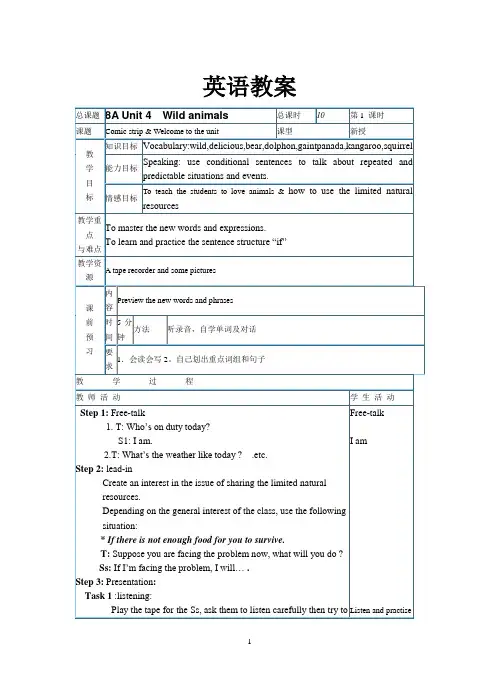
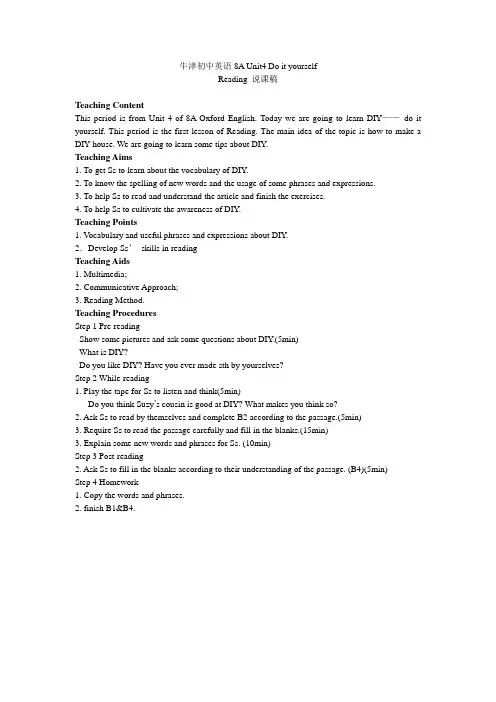
牛津初中英语8A Unit4 Do it yourselfReading 说课稿Teaching ContentThis period is from Unit 4 of 8A Oxford English. Today we are going to learn DIY——do it yourself. This period is the first lesson of Reading. The main idea of the topic is how to make a DIY house. We are going to learn some tips about DIY.Teaching Aims1. To get Ss to learn about the vocabulary of DIY.2. To know the spelling of new words and the usage of some phrases and expressions.3. To help Ss to read and understand the article and finish the exercises.4. To help Ss to cultivate the awareness of DIY.Teaching Points1. Vocabulary and useful phrases and expressions about DIY.2.Develop Ss’skills in readingTeaching Aids1. Multimedia;2. Communicative Approach;3. Reading Method.Teaching ProceduresStep 1 Pre-readingShow some pictures and ask some questions about DIY.(5min)What is DIY?Do you like DIY? Have you ever made sth by yourselves?Step 2 While-reading1. Play the tape for Ss to listen and think(5min)Do you think Suzy’s cousin is good at DIY? What makes you think so?2. Ask Ss to read by themselves and complete B2 according to the passage.(5min)3. Require Ss to read the passage carefully and fill in the blanks.(15min)3. Explain some new words and phrases for Ss. (10min)Step 3 Post-reading2. Ask Ss to fill in the blanks according to their understanding of the passage. (B4)(5min)Step 4 Homework1. Copy the words and phrases.2. finish B1&B4.。
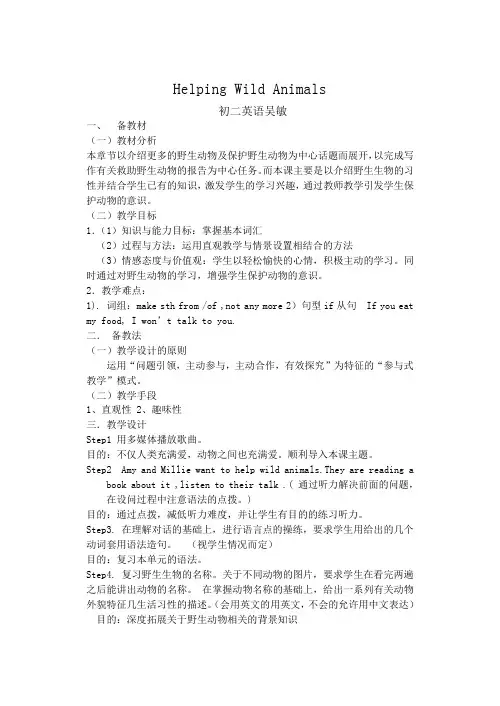
Helping Wild Animals初二英语吴敏一、备教材(一)教材分析本章节以介绍更多的野生动物及保护野生动物为中心话题而展开,以完成写作有关救助野生动物的报告为中心任务。
而本课主要是以介绍野生生物的习性并结合学生已有的知识,激发学生的学习兴趣,通过教师教学引发学生保护动物的意识。
(二)教学目标1.(1)知识与能力目标:掌握基本词汇(2)过程与方法:运用直观教学与情景设置相结合的方法(3)情感态度与价值观:学生以轻松愉快的心情,积极主动的学习。
同时通过对野生动物的学习,增强学生保护动物的意识。
2.教学难点:1). 词组:make sth from /of ,not any more 2)句型if从句 If you eat my food, I won’t talk to you.二.备教法(一)教学设计的原则运用“问题引领,主动参与,主动合作,有效探究”为特征的“参与式教学”模式。
(二)教学手段1、直观性2、趣味性三.教学设计Step1 用多媒体播放歌曲。
目的:不仅人类充满爱,动物之间也充满爱。
顺利导入本课主题。
Step2 Amy and Millie want to help wild animals.They are reading a book about it ,listen to their talk .( 通过听力解决前面的问题,在设问过程中注意语法的点拨。
)目的:通过点拨,减低听力难度,并让学生有目的的练习听力。
Step3. 在理解对话的基础上,进行语言点的操练,要求学生用给出的几个动词套用语法造句。
(视学生情况而定)目的:复习本单元的语法。
Step4. 复习野生生物的名称。
关于不同动物的图片,要求学生在看完两遍之后能讲出动物的名称。
在掌握动物名称的基础上,给出一系列有关动物外貌特征几生活习性的描述。
(会用英文的用英文,不会的允许用中文表达)目的:深度拓展关于野生动物相关的背景知识Step5.用小组活动的方式把学生分成4人一组进行,开展有关Tigers and wolves的描述。
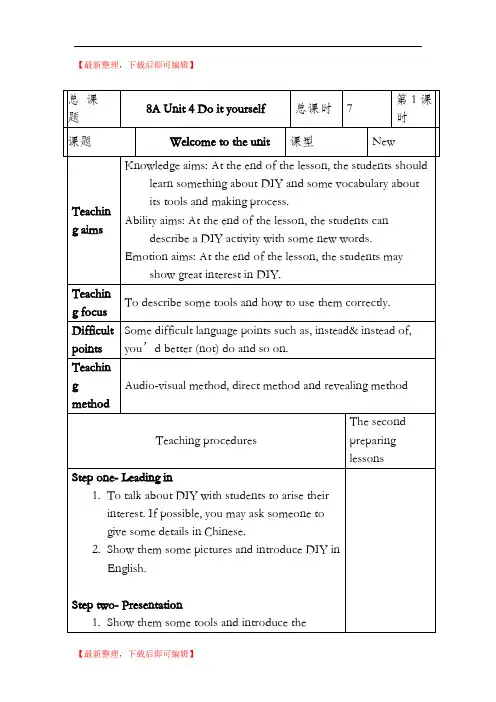
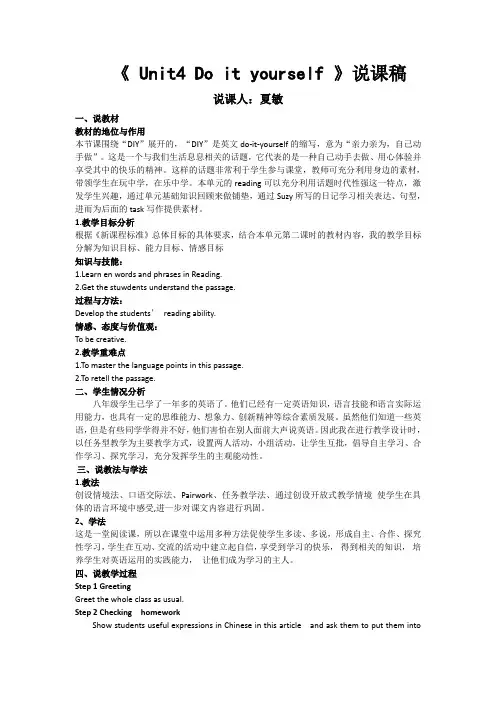
《 Unit4Do it yourself》说课稿说课人:夏敏一、说教材教材的地位与作用本节课围绕“DIY”展开的,“DIY”是英文do-it-yourself的缩写,意为“亲力亲为,自己动手做”。
这是一个与我们生活息息相关的话题,它代表的是一种自己动手去做、用心体验并享受其中的快乐的精神。
这样的话题非常利于学生参与课堂,教师可充分利用身边的素材,带领学生在玩中学,在乐中学。
本单元的reading可以充分利用话题时代性强这一特点,激发学生兴趣,通过单元基础知识回顾来做铺垫,通过Suzy所写的日记学习相关表达、句型,进而为后面的task写作提供素材。
1.教学目标分析根据《新课程标准》总体目标的具体要求,结合本单元第二课时的教材内容,我的教学目标分解为知识目标、能力目标、情感目标知识与技能:1.Learn en words and phrases in Reading.2.Get the stuwdents understand the passage.过程与方法:Develop the students’reading ability.情感、态度与价值观:To be creative.2.教学重难点1.To master the language points in this passage.2.To retell the passage.二、学生情况分析八年级学生已学了一年多的英语了。
他们已经有一定英语知识,语言技能和语言实际运用能力,也具有一定的思维能力、想象力、创新精神等综合素质发展。
虽然他们知道一些英语,但是有些同学学得并不好,他们害怕在别人面前大声说英语。
因此我在进行教学设计时,以任务型教学为主要教学方式,设置两人活动,小组活动,让学生互批,倡导自主学习、合作学习、探究学习,充分发挥学生的主观能动性。
三、说教法与学法1.教法创设情境法、口语交际法、Pairwork、任务教学法、通过创设开放式教学情境使学生在具体的语言环境中感受,进一步对课文内容进行巩固。
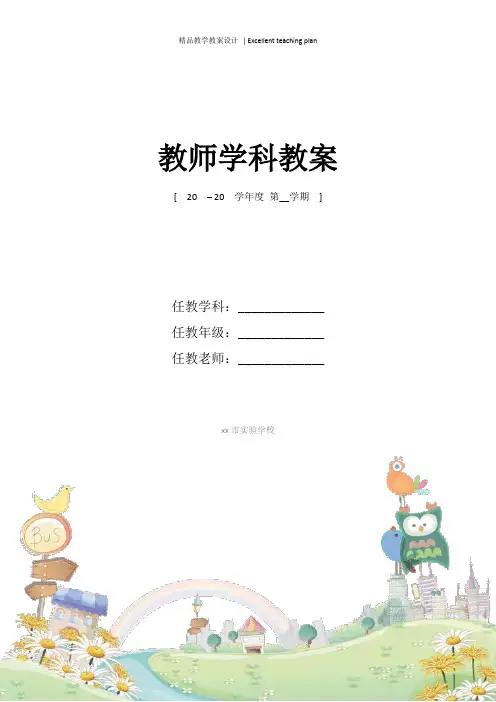
教师学科教案[ 20 – 20 学年度第__学期]任教学科:_____________任教年级:_____________任教老师:_____________xx市实验学校8A Unit4 Wild animalsPeriod OneTeaching content: Comic strips & Welcome to the unitTeaching goals:1.To introduce the topic and main task of th e unit. Help the students to focus on ‘Wild animals’2.To learn more about wild animals and then express their preference3.To think of ways to help the endangered animalsTeaching important & difficult points:1.Help the students to learn more about important words and phrases2.Help the students to learn more about wild animals and then express their preference 3.Help the students to think of ways to help the endangered animalsTeaching procedures:Step 1: Answering the questionTell the students that I have got a very difficult question to answer. And I would like to ask you to answer the question, too. Show the question on the board. And get the students to discuss about it.Get the students to talk about Question A first. (It may not be very difficult for the students to answer.) Then show the students Question B. Give the students a few minutes to discuss about the question. (For more able students, encourage them to speak out their questions, too. )Step 2: Listening and answeringTell the students that Eddie is now facing such a problem. Get the students to listen to the tape and then answer the following questions:1. Who has food? Eddie has food.2. Is he going to share his food with his master / e-dog?No, he isn’t going to share his food with Hobo.Step 3: Reading the dialogue together or in rolesGet the students to read the dialogue together or in roles. Ask the students to practice and remember the dialogue and then act it out.Step 4: Finishing the following exercisesGet the students to focus on possible actions and possible results of the dialogue. Then get them to finish the following exercises.Possible Actions Possible results1.If I don’t have food, I ___ (die).2.If I die, no one _________ (look) after you.3.If you eat my food, I _________ (not talk) to you.4.If Hobo doesn’t have food, he ____ (die).5.If Eddie dies, no one _________ (look) after Hobo.6.If Hobo eats Eddie’s food, Eddie __________ (not talk) to Hobo.Step 5: Getting to know about wild animalsMan is now having the same problem, too. Many animals share the same homeland with us. However, man has taken their food and their homes away. As k, ‘Do you think we should do something to help?’ (Yes.)Wild animals are our friends. It is important to protect wild animals. (Write the sentence on the board then get the students to read it aloud.)‘Let’s check how much you know about wild animals. Do you know them?’ Show the pictures of the animals.PICTURES NAMES SOMETHING ABOUT ITkangaroo It only lives in Australia. It has strong back legs, so it can jump very fast. A mother kangaroo has a pocket in front for its baby.bear It usually has black or brown fur. It is strong. It likes eating fish and honey. However, it doesn’t eat dead things.giant panda It only lives in China. It has black and white fur. It eats bamboo shoots and leaves. We have very few of them in China.squirrelIt is very lovely. It has a long and soft tail. Itlives in the tree. It likes eating nut very much.dolphin It is a kind of friendly people in the water. It can play a lot of tricks in water. People come to the zoo to see its swimming show.tiger It is the king of the forest. It looks like a cat but big than a cat. It has yellow fur with black stripes.Ask the students to give the names of the animals and then encourage them to speak out what they know about the animals, focusing on the appearance and something special about it.Step 6: Play a guessing gamePlay a guessing game. Write the names on pieces of papers and then invite some of the more able students to choose and say something of the animals (To make it easier, ask the students to use the first person). The other students should listen carefully and guess what animal it is.Bear:I am strong. Sometimes, I eat people. But if I find the people died, I don’t eat them.Who am I?Kangaroo:I have a pocket. My baby sleeps in my pocket. Who am I?Squirrel: I have a long and soft tail. I live in the tree. Who am I?Giant Panda: I have black eyes and four black paws. I like eating bamboo shoots(竹笋).Step 7: Talking the animal they like best/leastGet the students to talk the animal they like best/least. If possible, encourage them to mention some simple reasons.Step 8: HomeworkFind more information about wild animals and finish the exercises.8A Unit4 Wild animalsPeriod TwoTeaching content: Reading (I)Teaching goals:1.To develop the ability to guess general meaning form context2.To get to know the problems that the giant pandas are facing and then start to think of way to protect the pandas3.To get to know the importance of animal protectingTeaching important & difficult points:1. Help the students to develop the ability to guess general meaning form context2. Help the students to get to know the problems that the giant pandas are facing and then start to think of way to protect the pandas3. Help the students to get to know the importance of animal protectingTeaching Procedures:STEP 1 Talking about the animalsGet the students to talk about the animals once again. Play the guessing game. Write something about a kind of animal on pieces of paper. Invite some of the students to choose and read about the animal and the others try to guess what animal it is.Guess what they are?1. They are large and heavy. They have thick fur. They like eating sweet food and fish If they are hungry, they also eat man.2.They are lovely and clever animals in the sea. They like swimming in groups. They are very friendly to people.3.They come from Australia. They jump with their babies in their special packets.4. They have yellow fur with black stripes. They are the kings of the forest.5. They are the biggest animals on land. They eat grass.6. They are small animals with big tails. They like climbing trees and eating nuts.7. They live in China. They like eating bamboo shoots and leaves very much.STEP 2 Teaching the words ‘hunter’, ‘survive’ and ‘reserve’As students come to ‘giant pandas’, get the students to talk about whatever they know about giant pandas. As they mention there are few giant pandas now, teach the words ‘hunter’, ‘survive’ and ‘reserve’.To arouse the students’ interest, get the students to guess how heavy giant pandas are at birth. The teacher can also give them some choices to choose from. (e.g. 2 jin, 500 grams, 100 grams and 1 kilogram)STEP 3 Telling the students the right answerTell the students the right answer. (They may be amazed at the information.)Say ‘I have some pictures here. They show how the baby grows into a giant panda. Can you put them into the right order?’Show them the following pictures and ask them to put them into the right order.→→→→STEP 4 Listening to the first part of the passageTell the students, ‘Millie has f ou nd a report about giant pandas. Let’s read it and learn mor e aboutthe animal. But first let’s listen to the first part of the passage and answer the following questions.’STEP 5 Filling in the following tableSay ‘So it’s really amazing that the baby panda is so small. Do you want to know how it grows into a giant panda? Let’s open your books and read the passage.’ Get the students to read the passage and fill in the following table.Ask ‘What did Xi Wang at different time?’ Get the students to read and find out.STEP 6 Finishing Part CGet the students to finish Part C: the growth of Xi Wang. Look at the pictures and get the students to read the sentences here loudly. This will once again consolidate the students’ understanding of Xi Wang’s growth.STEP 7 Reading and finding out the problemSay ‘Are pandas lovely? (Yes.) However, they are now in danger. It is hard for them to survive in the wild. (Write the sentence on the board.)They are facing a lot of problems. Can you find them out?’ Get the students to read and find out the problem and what people did to solve the problems.STEP 8 Finishing Part DHunters, farmers and some people did something bad to giant pandas. Get the students to say something to them.Hunters you shouldn’t kill giant pandas for their fur. AND SO ON.Get the students to finish Part D, Page 62. Check the answers.STEP 9 DiscussionDiscussion:A s a m i d d l e s c h o o l s t u d e n t,c a n y o u t h i n k o f s o m e g o o d i d e a s t o p r o t e c t p a n d a s? STEP 10 Homework:Read the passage and finish off the exercises in the books.8A Unit4 Wild animalsPeriod ThreeTeaching content: Reading (II)Teaching goals:1.To read the passage once again for more details2.To read the passage again and figure out how the writer organize the passage3.To r ead the passage and focus on the language points to improve the students’ fluency andaccuracy talking about giant pandas4.To d evelop students’ responsibilit y towards the endangered animalTeaching important & difficult points:1.Help the students to figure out how the writer organize the passage2.Help the students to learn the language points of the text3.To d evelop students’ responsibilit y towards the endangered animalTeaching Procedures:STEP 1 Reading the passage aloud togetherGet the students to read the passage aloud together. Invite them to finish the Part B, Check the answers. (This may offer the less able students another time to consolidate the new words.) STEP 2 Finishing off Part EAsk the students to finish off Part E, Page 62. Use this as a revision to help the students recall what they have learned last time.STEP 3 Working out the answersGet the students to read the passage together once again and then divide the class into groups of 4-5. Ask them to work out the an swer to the following question ‘How many parts are there in the passage.’Give the students enough time to talk about it. And then invite some of them to express their personal opinions. (Students should be encouraged to speak out what they think.)STEP 4 Finishing the following exercisesGet the student to talk about Part I. Invite them to talk about the growth of Xi Wang by finishing the following exercises:Then get the students to analyze the sentences: the when-clauses in each sentence give us a past time, so the main clauses use Simple Past Tense. (Students may come to the conclusion through observation.) Then get the student to underline such sentences in the passage.STEP 5 Finding them out‘During the growth of Xi Wang, Xi Wang had many ‘first-times’ Can you find them out.’ Use the following exercises to help students.In this way, the teacher directs the students attention to the use of ‘to’-infinitives afte r ‘start’ and ‘begin’.STEP 6 Rewriting sentencesSay ‘Sadly, it is very difficult for giant pandas to survive in the wild.’ and write the sentence on the board. Then try to rewrite the sentence into the following sentences.‘It is dangerous for giant pa ndas to live on in the wild.’ ‘They are in danger.’These are some very important sentence patterns in the passage. Also it is necessary for the teacher to point out that ‘live on’ has a similar meaning with ‘survive’. This may also help the students to un derstand that we can use ‘be dangerous’ or ‘be in danger’ to talk about a similar situation.STEP 7 Finding out that why they are in dangerGet the students to find out that why they are in danger. To make the task easier, the teacher canshow the following before hand.As a result, the students’ attention will be easily drawn to the use of ‘if’-clauses. Guide the students to focus on the tense of the subordinate- clauses and main clauses. (I think it is OK for some teachers to use ‘主将从现’ to make su mmary here. At least it may help the students to remember this phenomenon.)Explain the phrases here ‘kill…for…’, ‘cut down’, ‘have nowhere to live’ ‘find sb. adj’ and ‘take…away’.STEP 8 Talking about the actions people take to protect the pandasSay ‘If we do nothing, soon there will be no giant pandas in the world.’ and then get them to talk about the actions people take to protect the pandas. We must take the following actions to protect them. We can make giant panda reserves bigger. • We can build more reserves . • We can encourage farmers to leave the giant panda reservesDirect students’ attention to the use of ‘make sb. adj.’ and ‘encourage sb. to do sth.’ . If time permits, give more examples.STEP 9 Reading though the whole passage againGet the students to read though the whole passage again, focusing on the different language points.STEP 10 More exercises about the language pointsDo more exercises about the language points to check.1.She looks _____________(health).2.When Tom was born, he ___________(weigh) 6 jin.3.We should encourage him ___________(help) his good friend.4.We ask the ___________(hunt) not to hunt the animals.5.If it snows tomorrow, the primary school students _______(stay) at home.6.Now many pandas are in ________(dangerous)7.Two years _____(late), he became a famous reporter.8.The giant panda likes eating bamboo ____ (shoot) and ____(leaf) very much.STEP 11 Do some translation workSTEP 12 Homeworka. Try to retell the growth of Xi Wang.b. Discuss how to protect the giant pandas.c. Finish off the exercises in the Handbook (period three).8A Unit4 Wild animalsPeriod FourTeaching content: Grammar(I)Teaching goals:1.To understand the use of if-clauses and use conditional sentences to talk about possible situations2.To make a summary of the if –clauses3.To collect more information about different kinds of animalsTeaching important & difficult points:1.Help the students to understand the use of if-clauses and use conditional sentences to talk about possible situations2. Help the students to make a summary of the if –clauses3. Help the students to collect more information about different kinds of animalsTeaching Procedures:STEP 1 Telling what animal to seeIn the former part of this unit, we have already learned about a lot of animals. Get the students to tell me what animal we will see if we go into the forest. Ask the students to use the following sentence pattern.If we go into a forest, we will see___________.As students are taking about the animals we will see in a forest. The teacher may go on personalize the questions.In this way, the teachers may get the students to use conditional sentences fluently and accurately before come to any rules. It will help the students to understand the rules of conditional sentences better. Write some of the sentences on the board and get the student to read them. Direct students’ attention to the tense used in the clauses.They may find that people use simple present tense with if-clauses, while simple future tense with the other clause. (It is Ok for teachers to use ‘主将从现’ to give a summary to this. )STEP 2 Reading the sample sentencesGet the students to read the sample sentences on page 64. Tell the students that Amy is thinking about wild animals, too. Ask the students to do part A1. Check the answer in pairs and then check it in class.Help the students to focus on some of the sentences and explain the phrases here.STEP 3 Reading the last sentences in Part A1Read the last sentences in Part A1. If I have time next weekend, I will go to the zoo. Say ‘If I have time, I wil l go to the zoo(, too).’ Try to put the if-clause at the end of the sentence. ‘I will go to the zoo if I have time. ’ Write the two sentences on the board.Students may easily work out the rule: We need a comma after the ‘if’-clause when it is the first part of a sentence.STEP 4 Talking about what will happenGet the students to talk about ‘what will happen if you go to the zoo.’ Ask the students to use the following sentence structures:If I go to the zoo, I _________________ __.I will _________________ if I go to the zoo.Encourage the students to make as many sentences as possible.STEP 5 Completing the Part A2Tell the students that Amy wants to go to Beijing Zoo. She is writing some sentences to tell her parents why she wants to go.Students complete the Part A2, Page 65. Afterwards, get students to check in pairs. Read the sentence one by one to students and stop to explain the language points:‘learn a lot about’, ‘see the feeding of animals’, ‘have fun’ and ‘enough + n’.enoughSTEP 6 Finishing off the exercises in Part A3Say ‘Amy learned a lot about the animals in Beijing Zoo. Let’s see what she learned. Get the students to finish off the exercises in Part A3. Check the answers in pairs first and then check it in class.Get students to read the dialogue in roles. Help them to get more information about animals.Get students to guess the meaning of ‘attack’ a nd then get them to read and remember it.STEP 7 HomeworkFinish off the exercise in the books.8A Unit Four Wild animalsPeriod FiveTeaching content: Grammar C & V ocabularyTeaching goals:1. To give reasons with because and because of.2. To learn the new words about different animals.3.To talk about what each animal eats.Teaching important & difficult points:1.To grasp the new words about different animals.2. Giving reasons with because and because ofTeaching Procedures:Step 1. Revision1.Conditional sentences. We use them to talk about possible situationsIf____________,____________= _____________if_________2.practice: Let’s begin a speaking chain like the following:A: If he gets up late ,he will miss the bus.B:If he misses the bus ,he will be late for school.C:If he is late for school,his teacher will be angry.D:If his teacher is angry,she will ask his mum to come to school.E: If……, That’s terrible!Step 2 Presentation1.To give reasons with because and because of.2 .Finish the exercises on P672.Discuss---Write ‘because of’ sentences as many as possible on the board.(competition)3.Find the differences between ‘because’and ‘because of’ ,then try to use ‘because’ instead of ‘because of’Step 3 ConsolidationIf tigers live in the wild, they____ ( hunt ) for their own food. they live as a family if they ____ ( have ) babies . Baby tigers _____ ( learn ) how to catch other animals if they watch their mothers.Wolves live in family groups if they _____( be ) in the wild. They hunt together if they _____ ( be ) hungry.Step 4 Presentation1. Show some pictures of different animals and ask Ss to talk about them.2. Do Part A on Page 63 and check the answersStep 5 Practice1. Do Part B on Page 63, ask and answer in pairs.Step 6 Homework1. Revise the grammar.2. Finish off the exercises and review the new words about animals.8A Unit Four Wild animalsPeriod SixTeaching content: Integrated skills & Study skillsTeaching goals:1.To identify specific characteristics, appearance, abilities, eating habits and danger in thecontext of animals.2. To develop students’ability to infer meaning from context and key words.3. To listen and develop the ability to extract information in order to complete two fact sheets.4. To learn more about the endangered animals.5. To identify intonation patterns in conditional sentences.6. To read the conditional sentences in correct Pronunciation.Teaching important & difficult points:1. To learn more about the endangered animals2. To read the conditional sentences in correct Pronunciation.Teaching Procedures:Step1. Revision1. As we have learned a lot about animals in the unit, in this part we can directly come to thetwo animals we are going to talk about.2. Show the pictures of tigers and wolves one by one and encourage the students to speak outwhat they know about them.Step2. PresentationGet the students to listen and complete the fact sheets.Step3.ExplanationExplain the bold-faced words and expressions above to the students. Pay special attention to: ‘yellow fur with black stripes’, ‘live alone’ ‘hunt…for…’ and ‘loss of the living areas’. It is important because students may need these to write or talk about tigers, wolves as well as other animals.Step4. Practice1.Get the students to talk about the two animals looking at the two facts sheets. Encourage them students to start like this.Tigers are the largest living cat in the world…..Wolves are dog-like animals. They are not very big…..2.Get the students to complete the letter in Part A2, Page 69.First, let the students complete the passage by themselves.Then, get the students to check the answers in pairs.Afterwards, check the answers in class. The teacher can get two students to read out the facts about tigers and wolves, while the others correcting their answers.Finally, get the students to read the passage aloud.3.Invite the students to underline the important phrases by themselves. Explain some of themost important ones, like ’write to sb. about doing sth.’ and ‘made sth from sth.’.4.Show the students some pictures of the animals we have leaned. Encourage them to talk about the animals. They can talk about their appearance, ability, character, food and danger. Encourage them to ask more people to help protect the animals.Step5.RevisionWrite the following sentences on the blackboard and invite the students to read them.1. If tigers are hungry, they will attack people.2. If giant panda have no food, they will die.3. If polar bear id hungry, it catches fish from the water.4. What do male wolves do if there is danger?Step6. Presentation1. Remind Ss of communicative purpose of conditional sentences.2. Play the recording for Part A and ask Ss to listen carefully. Ss imitating the rising and falling voice patterns.3. Ask students to read Simon’s presentation with correct the rising and falling voices.4. Ask students to read Millie’s presentation in Part B quietly on their own. Play the recording. Ask Ss to listen carefully and mark where Millie’s voice rises and falls with the correct arrows5. Tell students to read them again, and answer the ‘Wh-’questions. Students work in pairs.Step7.SummaryStep8. Homework1. Organize the information in the two fact sheets into two passages about tigers and wolves.2. Find another endangered animal and write about it.3. Finish off the exercises and review the whole key points in this unit.8A Unit Four Wild animalsPeriod SevenTeaching content: Main taskTeaching goals:1.To grasp the new words: peaceful, female, mice, upright, daytime.2.To express something about animals.3. To write a report for the Wild Animals Club.Teaching important & difficult points:1.To grasp the new words: peaceful, female, mice, upright, daytime.2. To write a report on an animal in danger for the Wild Animals Club.Teaching Procedures:Step 1. Revision1 How many __________(baby) can a female giant panda have at a time?2 It is getting _________and ________(hot). We must put all the food into the fridge.3 Don’t keep me ________(wait) for you every time.4 They are good at ________(run) and ___________(jump).5 _________(monkey) like eating bananas and apples.6 Giant pandas are very _________(quietly) and ____________(peace).7 Don’t spend so much ti me _________(watch) TV.8 Yesterday Xiao Ming fell down from the bike and _________(hurt) his leg.1.他们很安静和平2雌性熊猫一次生一到两个婴3数量越来越少4他们的许多生存地正变成农场5如果农民们继续占用土地,大熊猫将没有地方生存6如果这个再继续下去,世界上将没有大熊猫了7给报纸和杂志写信8如果更多的人知道这些问题,可能他们会做些什么。
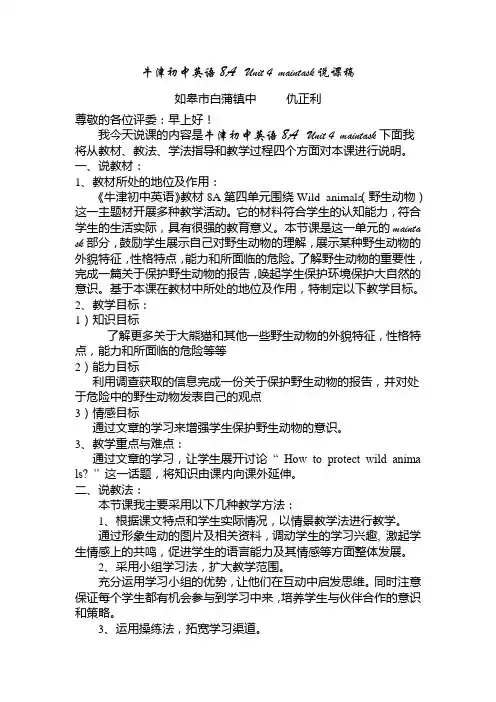
牛津初中英语8A Unit4 maintask说课稿如皋市白蒲镇中仇正利尊敬的各位评委:早上好!我今天说课的内容是牛津初中英语8A Unit4 maintask下面我将从教材、教法、学法指导和教学过程四个方面对本课进行说明。
一、说教材:1、教材所处的地位及作用:《牛津初中英语》教材8A第四单元围绕Wild animals(野生动物)这一主题材开展多种教学活动。
它的材料符合学生的认知能力,符合学生的生活实际,具有很强的教育意义。
本节课是这一单元的mainta sk部分,鼓励学生展示自己对野生动物的理解,展示某种野生动物的外貌特征,性格特点,能力和所面临的危险。
了解野生动物的重要性,完成一篇关于保护野生动物的报告,唤起学生保护环境保护大自然的意识。
基于本课在教材中所处的地位及作用,特制定以下教学目标。
2、教学目标:1)知识目标了解更多关于大熊猫和其他一些野生动物的外貌特征,性格特点,能力和所面临的危险等等2)能力目标利用调查获取的信息完成一份关于保护野生动物的报告,并对处于危险中的野生动物发表自己的观点3)情感目标通过文章的学习来增强学生保护野生动物的意识。
3、教学重点与难点:通过文章的学习,让学生展开讨论“ How to protect wild anima ls? ”这一话题,将知识由课内向课外延伸。
二、说教法:本节课我主要采用以下几种教学方法:1、根据课文特点和学生实际情况,以情景教学法进行教学。
通过形象生动的图片及相关资料,调动学生的学习兴趣, 激起学生情感上的共鸣,促进学生的语言能力及其情感等方面整体发展。
2、采用小组学习法,扩大教学范围。
充分运用学习小组的优势,让他们在互动中启发思维。
同时注意保证每个学生都有机会参与到学习中来,培养学生与伙伴合作的意识和策略。
3、运用操练法,拓宽学习渠道。
把大部分课堂时间留给学生,使学生在多信息、高密度、快节奏的灵活操练过程中拓宽学习渠道。
三、学法指导:八年级的学生已具有一定的英语写作能力,听说能力在原有的基础上也得到了进一步的提高,但参与课堂的积极性有所下降。
8A unit4 Wild animals—Vocabulary教学设计说课稿一、设计理念(Teaching Theory):本节课的设计思想是从学生的学习兴趣、生活经验和认知水平出发,倡导体验、参与、合作与交流的学习方式,采用任务型的教学途径,发展学生的综合语言运用能力,使语言学习的过程成为学生形成积极的情感态度、主动思维和大胆实践、提高人与自然的意识和形成自主学习能力的过程。
在教学过程中我采用了以学生为中心的教学方法,使学生在整个学习过程中一直处于一种积极的主动的学习状态,即:学生与学生之间、教师与学生之间始终处于互动、合作的状态,以期达到听中学;做中学;听懂了说出来;会做的写出来的境界。
二、教材分析本课选自[牛津英语]教材8A Unit4 Wild animals。
本教材在设计和编排上与“以人为本”的理念是一致的,能通过教学活动使学生的语言概念,语言实践能力和语言能力在原有的基础上得到拓展和加深。
内容丰富,融入了一些曰常生活中经常接触的单词和句型,通过学习能使学生掌握一定的听、说、读、写的技能。
它突出的特点是循序渐近,由易到难的知识结构非常符合学生的心理特征和认知规律。
本节课时的教学内容是第四单元的第四板块——词汇。
词汇部分在每个单元里是属于拓展性的,有助于我们将本单元话题有关的词汇、句型有机结合,同时将以前学过的相关内容归纳到一起。
因此,本节课试图解决三个问题:(1)对词汇的趣味教学作些尝试;(2)创设合适的语境使用所学词汇;(3)通过一些数字化资源介入让学生明白保护野生动物的重要性。
三、教学目标(Teaching Aims):1、认知目标(Knowledge Aims):(1)理解、掌握和运用野生动物的词汇。
(2)理解野生动物和他们最喜欢的食物。
2、技能目标(Skill Aims):(1)能够描述野生动物的外表、能力、特点等。
(2)着重培养学生的口语表达能力;(3)帮助学生形成合适的学习词汇的策略(4)培养学生合作学习和探究学习的能力。
江苏牛津英语初二8A第四单元说课教案(全英)Unit Four Wild animals VocabularyToday I want to talk about the fourth unit of Wild Animals, Vocabuary 8A Oxford English .1.The Analysis of the textbook , including the contents , the teaching aims , the Focus and the difficulties2.The teaching methods3.The design of the teaching procedure and the class activities4.Evaluation and ReflectionI: T he Analysis / / of the t extbook1). the contentsThe part of the Vocabulary in the fourth unit startes the topic according to the animals It is a training in listening, speaking, reading and writing ability of students,To make the students learn to observe and to take an interest in the animals so that they can pay attention to their living.2)The teaching aims (the knowledge , the abilities and the emotions )The aims of the knowledge : to master the different names of the animals The aims of the abilities : to improve the abilities of hearing speaking , writing and reading.The aims of the emotion : improve their love for the animals in order to raise the consciousness of the student's protection of the wild animal3) The teaching points and the difficulitiesThe points of this lesson; to master the words such as fox , polar ,bear , wolf and insectThe difficulties of this lesson: the training of the language expressionsII. The teaching methods and the waysTeaching the students by the five teaching steps gradually to emphasize the contents . The teacher is to act the guide and the students as an actor to do the activities .In class we can use the modern teaching equipments to make the class interesting and lively .III. Teaching procedure and the aims of the designI) Revision1) Show the picture of Page 55, saying , “boys and g irls , do you know these animals ? Name them together ,please.”2) Ask the students questions, saying, “ Which one do you like best ? Why ? ” ( ask four students to answer )3) Point to the panda, saying , “ Look at the giant panda. It’s our nati onal animal. It’s my favourite . How much do you know about it ? ” (ask the six students to answer )II) Lead in1) Ask the students : Do you want to see some other animals ?2) Show the picture of Page 59, asking : What are their names?Then teach the new words such as fox , polar, bear and wolfIII. Practice1) Complete the following the missing vowels (Omit)2) Show the pictures in the right order to make the students tell the names of the animals (saying together)3) Play guessing games :One student shouts like an animal or make an action and the other students guess the name of the animalIV. Practice1) Show the bamboo shoots , fish ,fruit ,grass , insects , leaves and the vegetables in turn , asking : What can you see?Teach the word insect2) Ask questions like that: Which animal likes eating bambooshoots ? (Ask the students to answer the full sentence)3) Ask : Which one do you like best ? Why ?V. WritingTeacher: I like all of them . The world are so beautiful because of them . Now please think about these questions and write your answers down .To show the two questions:1) What would happen if they disappeared from the world ?2) What should we do to protect them ?If the students can’t finish the work in class, ask them to finish it after class.5 December 2006。
《8A Unit 4 Do it yourself Integrated skills》教学案教学目标:教学重、难点:从听力材料中准确捕获相关有用的信息。
课前预习词组翻译教学过程Step 1 RevisionGet the students talk about some characteristics of and wolves.(If they have any difficulties, they can say that in Chinese.)Step 2 Presentation (Integrated skills A)1 Invite students to talk about what they like about tigers and wolves. Brainstorm any information and general knowledge about the two animals.2 Ask Ss to study the two fact files in pairs. Check the meaning of some of the words. Step3 Listening and Answering1 Help Ss focus on the general context by asking general questions they may be able to answer while listening for the first time. Write them on the Bb:* What is the name of the largest living cat?* What is Millie’s favorite animal?Play the recording. Students listen carefully for keywords to answer the questions.2 Play the recording for again and ask students to find out the missing facts in the fact sheets. Play the ta pe for the third time for Ss to check the answers.Step 4 Consolidation1 Ask Ss to read the letter in pairs and discuss any words they do not understand. Complete the letter without looking at the fact sheetson page2 Then ask them to look at the fact sheets to check the answers and make corrections if necessary.3 Ask more able Ss to read aloud the letter.Step 5 Presentation (Integrated skills B)1 Ask students to practice the conversation in pairs and then change roles. Identify any words or phrases they do not know.2 Ask students to create their own conversation using information from the fact sheets. Step 6 Pr acticeGet the students to read the dialogue in pairs. Then invite some pairs to act out.知识梳理1 Live as a family until baby tigers are 2-3 years old.在小老虎两到三岁前以家庭形式居住。
牛津英语8A Unit Four 教案Sentence For YouAction speaks louder than words. 行动胜于言语!学习目标:1. 了解一些动物的生活习惯和习性2. 掌握文中的重点词汇和句型3. 掌握条件状语从句和原因状语从句的用法知识重点:1.条件状语从句和原因状语从句的运用3. 课文中的重点短语和句型的运用知识难点:条件状语从句和原因状语从句准确运用检查落实及知识回顾:1. 听写上节课布置的单词,词组。
2.抽读上节课要求的课文3.检查上节课布置笔头作业4.对上节课知识点进行提问单项选择:1) The boy made a model plane all by .A. heB. himC. hisD. himself2) He sat there in class his heart was left.A. andB. orC. butD. yet3) He told the boys football in the street.A. not playB. don’t playC. not to playD. to not play4) The bridge stone.A. is made ofB. is made fromC. is made toD. is made by5) We can go to the Summer Palace .A. by a coachB. by coachC. on coachD. on his coach Keys: D; C; C; A; B授课内容:·Phrases1.look delicious 看起来好吃2.talk to 和…说话3.look after 照顾4.the baby panda 小熊猫5.look like 看起来像6.at four months old 四个月大7.grow into 长成8.at the very beginning 在最初的时候9.bamboo shoot竹笋10.in the future 在将来11.cut down 砍伐12.in danger 在危险中13.take the following actions 采取以下措施14.encourage … to … 鼓励…做…15.walk through穿过16.get enough information for my report 为我的报告找到足够的信息17.live alone独居18.work as a team 团队合作19.the loss of living areas 居住地的丧失20.have very good eyesight, hearing and smell 有不错的视力,听力和嗅觉21.look lovely on me穿在我身上和可爱22.lose their lives 丧命23.give them good areas of forest 给它们森林里的好地方24.have suitable homes 有合适的家园25.make a lot of money 挣很多钱26.sell elephants’ tusks 出售象牙27.at a time 一次28.look like little white mice 看起来像小白鼠29.keep taking the land 不断侵占土地30.have nowhere to live 没地方住31.move around in the daytime 白天出来活动32.see a dolphin show 看一场海豚表演Important sentences:1.Can I have some food?Can I have…eg. Can I have some more bread?2.We called her Xi Wang.call sb. sth sth 为宾语补足语补充:判断xi wang 是否为宾语补足语时,在xi wang前加be 动词is,将宾语和后面的成分连成一句话, 即: she is xi wang. 从逻辑关系角度看,这句话是成立的.所以xi wang为宾语补语eg. We call the baby panda Xiwang.3.Sadly, it is very difficult for giant pandas to survive in the wild.It is+ adj. for sb. to do sthEg. It is important for us to learn English well.4.If hunters catch a giant panda, they will kill it for its fur.kill sth for sth .Eg. Hunters kill tigers for their furs and bones.5.I will learn a lot about animals.learn about sth.eg. I like learning more about foreign countries.6.I don’t think that’s right.谓语动词是 think, believe, suppose 等词时, 宾语从句中的否定式要前移到这些谓语动词前.Eg. I don’t think he will fail in this exam.7.Baby giant pandas spend a lot of time drinking their mum’s milk..spend some time/some monbey (in) doing sth.. spend some time/some monbey on sthEg. Every morning, I spend an hour reading English.How much did you spend on the book?8.The number is getting smaller and smaller.get smaller and smallereg. The ball is getting smaller and smaller.9.What action can the club take?take action to do stheg. We should take action to protect the environment.10.If we don’t protect giant pandas, they will die.If 引导的是从句,后面的句子是主句.if 翻译成“如果”, 即引导的条件状语从句.如果主句是将来时, if 引导的条件状语从句中谓语动词的时态则是一般现在时. (主将从现)eg. If it rains tomorrow, we will not go hiking.11.The wild animals cannot find enough food because of the heavy snow. because of +名词或名词性短语eg I was late for the school this morning because of the heavy traffic.enough : enough 位于名词前,形容词和副词后面.(名前幸福后)enough修饰形容词和副词时,其后接动词不定式,此时可用so…that 结构来互换. Eg. I walk fast enough to keep up with him.= I walk so fast that I can keep up with him.12.Many wild animals are in danger.be in dangereg. The giant pandas are in danger.13.She had to look after herself because her mother had another baby.have to do sth look aftereg. She can’t go with us because she has to look after her younger sisther. 14.How much do you know about wild animals?How much 可以用来问价钱的多少.也可以用来问数量的多少.(后接名词时,应为不可数名词)eg. How much water have you got? 你有多少水?How much are these apples? 这些苹果是多少钱?15.We can encourage farmers to leave the giant panda reserves.encourage sb. to do stheg. My parents encouraged me to face difficulties by myself when I was young. 16.Because wild animals are our friends on Earth , we are trying our best to protectthem.on Earth=in the worldon earth 意为“究竟”.位于 how, why, where, who 等词后.eg. Who on earth is the man? 那个人究竟是谁?try one’s best to do = do one’s best to doeg. I will try my best to catch up with my classmates.= I will do my best to catch up with my classmates.Grammar:1.条件状语从句:我们可以用条件句来谈论一个可能的行为的结果. If 翻译成“如果”结构: if+从句, 主句.主句+if从句注意: 如果主句中谓语动词是将来时, 从句中谓语动词的时态用一般现在时表示将来. Eg. If hunters catch a giant panda, they will kill it for its fur.=They will kill it for its fur if hunters catch a giant panda.Exercises:1) If you with us, you will be happy.A. goB. will goC. shall goD. went2) If it tomorrow, we will stay at home. We won’t go to the museum.A. rainB. rainsC. will rainD. rainedKeys: A; B2. because/ because of 的用法我们可以用because/ because of 给出事情的原因.because 后接句子, 为原因状语从句, because 常位于句子中间. because of 后接名词或名词性短语.eg. Xi Wang had to look after herself because her mother had another baby.It is very difficult for giant pandas to survive in the wild because of people. ·辨一辨1.die of / die fromdie of 因(病、饿、冻等)而死。
牛津英语初二8A第四单元说课教案(全英)Unit Four Wild animals V ocabularyToday I want to talk about the fourth unit of Wild Animals, Vocabuary 8A Oxford English .1.The Analysis of the textbook , including the contents , the teaching aims , the Focus and the difficulties2.The teaching methods3.The design of the teaching procedure and the class activities4.Evaluation and ReflectionI: The Analysis / / of the textbook1). the contentThe part of the V ocabulary in the fourth unit startes the topic according to the animals It is a training in listening, speaking, reading and writing ability of students,To make the students learn to observe and to take an interest in the animals so that they can pay attention to their living.2)The teaching aims (the knowledge , the abilities and the emotions )The aims of the knowledge : to master the different names of the animalsThe aims of the abilities : to improve the abilities of hearing speaking , writing and reading. The aims of the emotion : improve their love for the animals in order to raise the consciousness of the student's protection of the wild animal3) The teaching points and the difficulitiesThe points of this lesson; to master the words such as fox , polar ,bear , wolf and insectThe difficulties of this lesson: the training of the language expressionsII. The teaching methods and the waysTeaching the students by the five teaching steps gradually to emphasize the contents . The teacher is to act the guide and the students as an actor to do the activities .In class we can use the modern teaching equipments to make the class interesting and lively .III. Teaching procedure and the aims of the designI) Revision1) Show the picture of Page 55, saying , ―boys and girls , do you know these animals ? Name them together ,please.‖2) Ask the students questions, saying, ― Which one do you like best ? Why ? ‖ ( ask four students to answer )3) Point to the panda, saying , ― Look at the giant panda. It‘s our national animal. It‘s my favourite . How much do you know about it ? ‖ (ask the six students to answer )II) Lead in1) Ask the students : Do you want to see some other animals ?2) Show the picture of Page 59, asking : What are their names?Then teach the new words such as fox , polar, bear and wolfIII. Practice1) Complete the following the missing vowels (Omit)2) Show the pictures in the right order to make the students tell the names of the animals (saying together)3) Play guessing games :One student shouts like an animal or make an action and the other students guess the name of the animalIV. Practice1) Show the bamboo shoots , fish ,fruit ,grass , insects , leaves and the vegetables in turn , asking : What can you see?Teach the word insect2) Ask questions like that: Which animal likes eating bamboo shoots ? (Ask the students to answer the full sentence)3) Ask : Which one do you like best ? Why ?V. WritingTeacher: I like all of them . The world are so beautiful because of them . Now please think about these questions and write your answers down .To show the two questions:1) What would happen if they disappeared from the world ?2) What should we do to protect them ?If the st udents can‘t finish the work in class, ask them to finish it after class.牛津初中英语UNIT 2 School Life 说课稿Introduce myself:My name is Lu Guojuan. I have worked in Zhangqiao Middle School for 5years. Today I want to talk about Unit 2, School Life Reading, 8A, OxfordEnglish.First, the analysis of the textbook:1. The contents:The part of the reading in the second unit aims to introduce schoollife in British and American schools and it aims to get the students tolearn the differences between foreign culture and native culture.2. The teaching aims:(1)The aims of the knowledge: To learn life in a British school or anAmerican school and to master important language points.(2)The aims of the abilities: To improve the abilities of gettinginformation by scanning and the abilities of listening, speaking, readingand writing.(3)The aims of the emotion: To promote their love for their school andschool lives.3. The teaching emphasis:(1) To get the ability of general reading and acquiring information.(2) To master vital phrases and sentence structures.4. The teaching difficulties:(1)We have to tell our English teacher what we are reading.(2)This is great because it takes less time than taking the bus.Next, the teaching methods:Teach the students by the five teaching steps gradually to emphasize the contents. The teacher is to act as a guide and the students as anactor to do the activities.Then, the teaching aids:Projector, Slide show, Tape recorder and PicturesAfterwards, the design of the teaching procedure and the class activities. Step I Lead-in (within 5 minutes)1. Ask and answer about school life.1 )What subjects do you learn at school?2 )What after-school activities do you have?3 ) Have you joined a club?2. Ask two students to talk about his/her school life.Step II Presentation (within 30 minutes)Part A Show two flags with the words ‗Life in a British school‘ and ‗lifein an American school‘ and discuss the question: What do you think British or American school would be like?Part B 1. Listen to the tape about Passage One to get general ideas and think about two easy questions:(1) Who wrote the first passage?(2 )What activities does the school have every year?2. Read and complete the first five T or F exercises in Part C1 and correct them.Part C 1. Listen to the tape about Passage Two to get rough ideas and think about two easy questions:(1) Who wrote the second passage?(2) Who else are mentioned in the passage?2. Read then ask and answer:(1) What did Jim do in school last year?(2) How does Nancy go to school every day?(3) What do the students do in the Buddy Club?(4) What do American students do during lunchtime?(5) What do the students sometimes do after school?3. Complete the left T or F exercises in Part C1 and correct them.4. Read together with the tape .Part D Language points:(It aims to introduce their usage by some examples.)1. how to do something2. taste-tasty3. tell our English teacher what we are reading.4. as well & either5. It takes less time than taking the bus.6. drive me to school7. have a great time doing sthThere are some other useful phrases:1. near the end of each class2. have a driving lesson3. spend a lot of time doing4. Buddy Club5. talk to sb about sth6. enjoy this a lot7. help me learn about sthPart E Retell John‘s or Nancy‘s school life. (V olunteers)Step III Consolidation (within 5 minutes)Do exercises in workbook on Page 44 No. 6 and then check out the answers.Step IV Oral practice (within 5 minutes)1. Make up a dialogue with partner to talk about Nancy‘s school life. (onepair)2. Say something about our own school life. (one or two students)If I have some more time, I will ask the students to write down theirschool lives and read them out.Step V Assignment1. Retell John‘s or Nancy‘s school life.2. Write a composition about our own school life.Finally, evaluation and reflection:Evaluate the effect of this class and improve it afterwards.In addition, I will attach my design of the blackboard.Design of blackboard:Unit 2 School LifeWhat do you think British or American school would be like?Life in a British school Life in an American schoolLanguage points:1. tell our English teacher what we are reading2. as well & either3. It takes less time than taking the bus.4. have a great time doing sthThat‘s all. Thank you.牛津英语8A Unit 4 (1) 说课一、备教材(一)教材分析牛津英语8A第四单元以介绍野生动物及保护野生动物为中心话题而展开,以完成写作有关救助野生动物的报告为中心任务。